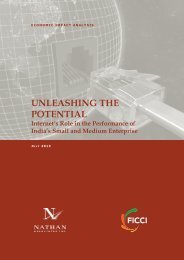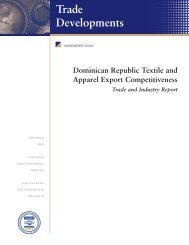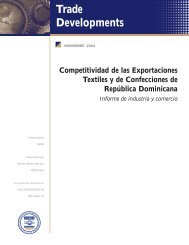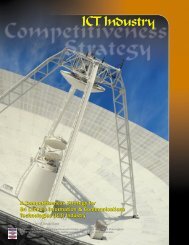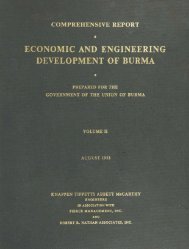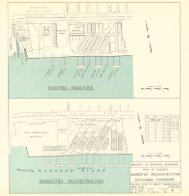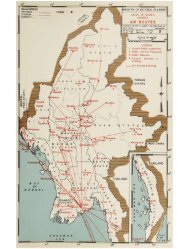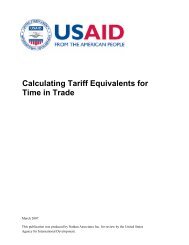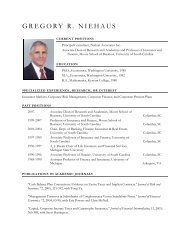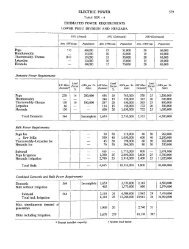Putting it to Work in Developing Countries - Nathan Associates
Putting it to Work in Developing Countries - Nathan Associates
Putting it to Work in Developing Countries - Nathan Associates
Create successful ePaper yourself
Turn your PDF publications into a flip-book with our unique Google optimized e-Paper software.
shot up <strong>to</strong> almost $16 billion <strong>in</strong> 2005, a new<br />
peak, but still represent<strong>in</strong>g only about 4 percent<br />
of all develop<strong>in</strong>g country <strong>in</strong>flows. Lebanon,<br />
Morocco, and Egypt recorded among them twothirds<br />
of the region’s <strong>to</strong>tal <strong>in</strong>flows between<br />
2001and 2005, and Algeria, Jordan, and Tunisia<br />
another quarter (see text box). General regional<br />
growth has occurred desp<strong>it</strong>e <strong>in</strong>stabil<strong>it</strong>ies created<br />
by the Iraq War and the Palest<strong>in</strong>ian conflict. In<br />
fact, Morocco and Lebanon experienced an<br />
upsurge <strong>in</strong> FDI <strong>in</strong>flows <strong>in</strong> 2003. Instabil<strong>it</strong>y no<br />
doubt severely depressed FDI receipts <strong>in</strong> other<br />
FDI <strong>to</strong> Middle East and North Africa 2001–2005<br />
FDI Inflows ($mn) FDI % GDP<br />
2005 2001–2005 2001–2005<br />
Region Total 15,840 44,383 1.7<br />
Lebanon 2,573 10,119 10.7<br />
Morocco 2,933 9,841 4.6<br />
Egypt 5,376 8,927 2.0<br />
Algeria 1,081 4,775 1.3<br />
Tunisia 782 3,313 2.7<br />
Jordan 1,532 2,831 5.4<br />
Other (8 countries) 3,877 4,577 0.3<br />
Develop<strong>in</strong>g <strong>Countries</strong> 285,144 1,034,754 2.8<br />
SOURCE: UNCTAD, WIR 2006;World Bank regional group<strong>in</strong>gs.<br />
regional economies: Iraq of course, but also Iran,<br />
Yemen and Syria.<br />
Several fac<strong>to</strong>rs probably drive FDI <strong>to</strong> the region.<br />
First, resource-seek<strong>in</strong>g FDI has been particularly<br />
important for oil and gas producers such as<br />
Algeria, Egypt, and Tunisia. Second, soar<strong>in</strong>g oil<br />
prices have provided liquid<strong>it</strong>y <strong>to</strong> encourage nondevelop<strong>in</strong>g<br />
country direct oil producers <strong>in</strong> the<br />
Gulf (e.g., Kuwa<strong>it</strong>) <strong>to</strong> <strong>in</strong>vest <strong>in</strong> regional<br />
economies, such as Jordan and perhaps<br />
Lebanon, <strong>in</strong> sec<strong>to</strong>rs such as real estate, construction,<br />
and <strong>to</strong>urism. Third, the proxim<strong>it</strong>y of the<br />
EU market and the trade relationships created<br />
by various Euro-Med<strong>it</strong>erranean Association<br />
Agreements—EU w<strong>it</strong>h Morocco, Tunisia, Egypt,<br />
and Jordan—have promoted export-oriented<br />
manufactur<strong>in</strong>g FDI <strong>in</strong> several countries. Other<br />
free trade agreements, such as the Jordan–US<br />
agreement that stimulated large-scale garment<br />
manufacture, may have encouraged FDI <strong>in</strong>flows.<br />
F<strong>in</strong>ally, economic liberalization programs,<br />
<strong>in</strong>clud<strong>in</strong>g privatizations, have attracted FDI <strong>in</strong><br />
several economies. Morocco privatized <strong>it</strong>s Régie<br />
des Tabacs <strong>in</strong> 2003, for example, and Jordan privatized<br />
electric power and telecommunications<br />
util<strong>it</strong>ies w<strong>it</strong>h UAE <strong>in</strong>ves<strong>to</strong>rs <strong>in</strong> 2005.<br />
W<strong>it</strong>h high prices for oil and other commod<strong>it</strong>ies,<br />
favorable trends <strong>in</strong> world and EU economic<br />
cond<strong>it</strong>ions and trade, and momentum for economic<br />
reform improv<strong>in</strong>g regional bus<strong>in</strong>ess environments,<br />
recent levels of FDI <strong>in</strong>flow can be<br />
susta<strong>in</strong>ed over the medium term. A boom<strong>in</strong>g<br />
world petroleum sec<strong>to</strong>r could mean <strong>in</strong>creased<br />
FDI for Algeria and Libya, the latter w<strong>it</strong>h very<br />
significant potential <strong>to</strong> attract FDI after years of<br />
economic sanctions. By contrast, persistence of<br />
current tensions and strife <strong>in</strong> Lebanon would<br />
discourage FDI <strong>in</strong>flows <strong>to</strong> that key economy<br />
and perhaps <strong>to</strong> the region as a whole.<br />
SOUTH ASIA—INDIA’S LEAD<br />
FDI <strong>in</strong>flows <strong>to</strong> South Asia have <strong>in</strong>creased over<br />
the past decade, but much more slowly than for<br />
the develop<strong>in</strong>g world as a whole. South Asia<br />
attracted nearly $10 billion <strong>in</strong> 2005, a record,<br />
though still less than 4 percent of all FDI flow<strong>in</strong>g<br />
<strong>to</strong> develop<strong>in</strong>g countries (see text box).<br />
Regional growth has been due almost entirely <strong>to</strong><br />
India, whose FDI receipts h<strong>it</strong> $6.6 billion <strong>in</strong><br />
2005, and whose <strong>in</strong>flows over the five years<br />
account for nearly 77 percent of the regional<br />
<strong>to</strong>tal. Pakistan is a distant second dest<strong>in</strong>ation<br />
w<strong>it</strong>h about $2.2 billion <strong>in</strong> 2005 and 14 percent<br />
of <strong>to</strong>tal regional <strong>in</strong>flows s<strong>in</strong>ce 2001. Other dest<strong>in</strong>ations,<br />
such as Bangladesh and Sri Lanka, have<br />
had fairly lim<strong>it</strong>ed <strong>in</strong>flows, though both boast<br />
qu<strong>it</strong>e liberal frameworks for FDI. Pol<strong>it</strong>ical tension,<br />
corruption and poor <strong>in</strong>frastructure <strong>in</strong> the<br />
former, and prolonged civil strife <strong>in</strong> the latter,<br />
have constra<strong>in</strong>ed FDI.<br />
India’s major FDI <strong>in</strong>flows have gone <strong>to</strong> IT,<br />
telecommunications, manufactur<strong>in</strong>g, and <strong>in</strong>dustry.<br />
But much of <strong>it</strong>s IT-enabled services and<br />
computer software enterprises have grown less<br />
through FDI than through nonequ<strong>it</strong>y contract<br />
35



